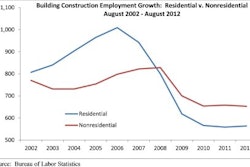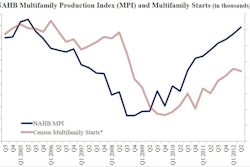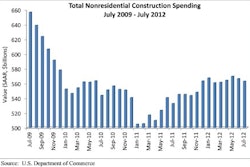Construction employers added 1,000 jobs in August while the industry’s unemployment rate fell to 11.3 percent, according to an analysis of new federal data released today by the Associated General Contractors of America. The unemployment declines come as the construction industry continues to shrink, association officials noted, adding that over 214,000 workers have left the industry since August 2011.
“While we all breathe a sigh of relief any time the sector adds jobs, these numbers are hardly cause for celebration,” said Stephen E. Sandherr, the association’s chief executive officer. “If it wasn’t for the fact that the housing sector is finally on the mend, construction employment would be heading in the wrong direction.”
Despite the monthly gains, the sector’s overall employment levels are essentially unchanged from a year earlier, Sandherr noted. He said that industry employment in August was only 17,000, or 0.3 percent, higher than one year earlier. There are now 5.5 million construction workers employed across the country compared to the peak levels of 7.7 million the industry hit back in 2006, Sandherr added.
The construction employment gains for the past month and past year have largely come from the residential sector. The residential construction sector added 7,100 jobs between July and August and 23,900 jobs since August 2011. Residential building contractors actually lost 1,000 jobs in August but have gained 5,200 for the year. Meanwhile, residential specialty trade contractors added 8,200 jobs in August and 18,700 for the year.
Nonresidential construction employment declined by 6,000 in August and is down by 6,400 for the year. Sandherr said that the heavy and civil engineering construction sector, buoyed by the passage earlier this year of a new federal transportation bill, added 2,800 jobs between July and August and 17,400 since August 2011. However, nonresidential specialty trade contractors lost 6,400 jobs for the month and 18,900 for the year. And nonresidential building contractors lost 2,400 jobs in August and 4,900 since August 2011.
The 11.3 percent unemployment rate for construction workers was below the rate in August 2011 of 13.5 percent. Sandherr cautioned, however, that the declines in the construction unemployment rate are happening because many frustrated construction workers are leaving the sector. Since August 2011, Sandherr notes that 214,000 contractors left the workforce while over 700,000 have left the industry since 2009.
Sandherr said construction employment remained stagnant as private sector demand remained relatively weak and overall public sector investments in construction and infrastructure continued to decline. He added that those declining infrastructure investments weren’t just hurting construction employment, but were also responsible in part for the fourth annual decline in America’s global competitiveness ranking.
“If we aren’t careful, we are going to neglect ourselves right into global mediocrity,” Sandherr said. “Instead of finger pointing and foot dragging, we need to start setting long-term tax rates, fixing critical infrastructure revenue challenges and passing measures to improve our aging drinking and waste water systems.”


















